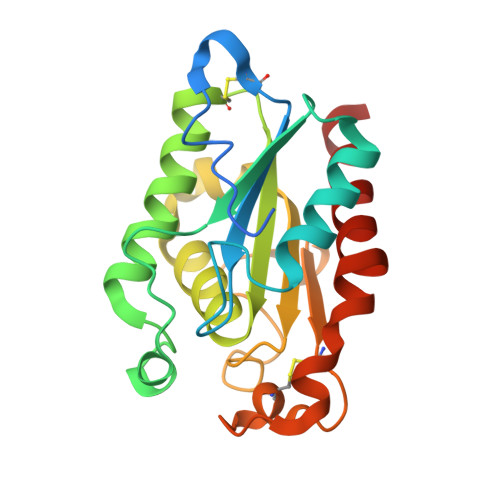Solid-state structural characterization of cutinase-ECE-pincer-metal hybrids
Rutten, L., Wieczorek, B., Mannie, J.P.B.A., Kruithof, C.A., Dijkstra, H.P., Egmond, M.R., Lutz, M., Klein Gebbink, R.J.M., Gros, P., van Koten, G.(2009) Chemistry 15: 4270-4280
- PubMed: 19219875
- DOI: https://doi.org/10.1002/chem.200801995
- Primary Citation of Related Structures:
3EF3, 3ESA, 3ESB, 3ESC, 3ESD - PubMed Abstract:
The first crystal structures of lipases that have been covalently modified through site-selective inhibition by different organometallic phosphonate-pincer-metal complexes are described. Two ECE-pincer-type d(8)-metal complexes, that is, platinum (1) or palladium (2) with phosphonate esters (ECE = [(EtO)-(O=)P(-O-C(6)H(4)-(NO(2))-4)(-C(3)H(6)-4-(C(6)H(2)-(CH(2)E)(2))](-); E = NMe(2) or SMe) were introduced prior to crystallization and have been shown to bind selectively to the Ser(120) residue in the active site of the lipase cutinase to give cut-1 (platinum) or cut-2 (palladium) hybrids. For all five presented crystal structures, the ECE-pincer-platinum or -palladium head group sticks out of the cutinase molecule and is exposed to the solvent. Depending on the nature of the ECE-pincer-metal head group, the ECE-pincer-platinum and -palladium guests occupy different pockets in the active site of cutinase, with concomitant different stereochemistries on the phosphorous atom for the cut-1 (S(P)) and cut-2 (R(P)) structures. When cut-1 was crystallized under halide-poor conditions, a novel metal-induced dimeric structure was formed between two cutinase-bound pincer-platinum head groups, which are interconnected through a single mu-Cl bridge. This halide-bridged metal dimer shows that coordination chemistry is possible with protein-modified pincer-metal complexes. Furthermore, we could use NCN-pincer-platinum complex 1 as site-selective tool for the phasing of raw protein diffraction data, which shows the potential use of pincer-platinum complex 1 as a heavy-atom derivative in protein crystallography.
Organizational Affiliation:
Crystal and Structural Chemistry, Bijvoet Center for Biomolecular Research, Faculty of Science, Utrecht University, Padualaan 8, 3584 CH Utrecht, The Netherlands.




















